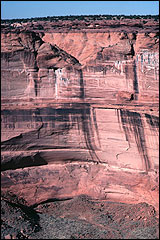Rocks
Updated February 21, 2017 | Factmonster Staff 

Rocks are classified in three types based on how they are formed.
- Igneous rocks are formed when molten rock (magma) from within Earth cools and solidifies. There are two types: intrusive igneous rocks solidify beneath Earth's surface; extrusive igneous rocks solidify at the surface. Examples: Granite, basalt, obsidian
- Sedimentary rocks are formed when sediment (bits of rock plus material such as shells and sand) gets packed together. They can take millions of years to form. Most rocks that you see on the ground are sedimentary. Examples: Limestone, sandstone, shale
- Metamorphic rocks are sedimentary or igneous rocks that have been transformed by heat, pressure or both. Metamorphic rocks are usually formed deep within Earth, during a process such as mountain building. Examples: Schist, marble, slate
The Rock Cycle:
The rock cycle explains how the different types of rock form.
The three types of rock at Earth’s mantle melt into magma.
Magma that cools and hardens underground forms intrusive igneous rock.
Weathering breaks the rock into sediment. Erosion causes the sediment to move to other locations.
Pressure squeezes the sediment together, forming sedimentary rock.
Heat and pressure change igneous and sedimentary rock into metamorphic rock.
Did You Know?
Most of the ocean floor is made of basalt. This igneous rock continues to flow out of Earth from chains of underwater volcanoes known as “mid-ocean ridges.”
See also:

